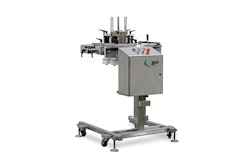Flexible food packaging has grown at an average annual rate of 4 percent by volume since 2010, and the availability of new packaging films, substrates, inks, adhesives and application methods seems to be growing even faster. The drive to capitalize on “the new and the now” has left the market filled with misinformation and misunderstandings. The only way for packagers to ensure compliance and reduce the likelihood of their packaging causing chemical contamination is to perform migration testing.
This article will explain five critical elements needed for migration testing that will adequately duplicate flexible packaging in situ. Understanding the key factors will help ensure the tests produce legitimate results that could be used in a go/no-go decision on packaging materials.
FALLACY #1: All substrate films are functional barriers that will prevent migration of chemicals used in packaging.
Not all polymeric films act as functional barriers, and even those that do don’t always perform this duty well in all applications and conditions. Barrier properties vary depending on the film’s thickness, the environmental conditions (particularly temperature), and the food contained within. Probably the most frequently used barrier film is linear low-density polyethylene (LLDPE), but it is a poor barrier under certain conditions. Even some metallized films may not provide a functional barrier, with the metal providing more of an aesthetic quality rather than barrier qualities. Data from our laboratory indicate that the metallization process may damage the barrier film and enhancing migration.
The common polymeric films listed below are ordered for barrier functionality (based on comparable thicknesses and application).
Linear low-density polyethylene (LLDPE) < High-density polyethylene (HDPE) < Polypropylene (PP) < Polyethylene terephthalate (PET)
Unfortunately, there is very little guidance from the Food and Drug Administration (FDA) or the European Food Safety Authority (EFSA) detailing adequate functional barrier properties. The only way to know if a film is suitable as a functional barrier is to perform migration testing using the real component chemicals and food simulants in condition-of-use scenarios.
FALLACY #2: Testing materials at a single temperature is suitable for any packaging.
To generate acceptable material performance data, migration testing must incorporate temperature to recreate the conditions in which the packaging will be used. Will it encounter hot-fill or retort? Is the package to be refrigerated or frozen? Is it designed for consumer microwaving?
FDA provides 10 factors for temperature conditions of use (EFSA provides separate guidance.):
A. High temperature, heat sterilized or retorted at approximately 121ºC (250ºF)
B. Boiling-water sterilized 100ºC (212ºF)
C. Hot filled or pasteurized above 66ºC (150ºF)
D. Hot filled or pasteurized below 66ºC (150ºF)
E. Room-temperature filled and stored (no thermal treatment in the container)
F. Refrigerated storage (no thermal treatment in the container)
G. Frozen storage (no thermal treatment in the container)
H. Frozen or refrigerated storage: ready prepared foods intended to be reheated in container at time of use
I. Irradiation (ionizing radiation)
J. Cooking at temperatures exceeding 121ºC (250ºF)
FALLACY #3: If a chemical doesn’t exceed migration limits in a short-term test it will be safe to use.
Length of exposure must be accounted for in migration testing, and can be done so using an accelerated process. FDA and EFSA have provided guidance for each condition of use to address shelf life. For example, FDA recommends testing at 40°C for 10 days to mimic 6-12 months shelf life for food stored at room temperature.
FALLACY #4: All materials react the same way to any one particular food simulant.
The character of a food – fatty, acidic, aqueous, alcoholic – significantly impacts the potential for chemical migration. FDA and EFSA recognize a number of food simulants that can be used in lieu of actual foods to generate acceptable chemical interaction data in migration testing. The FDA has not recommended a simulant for dry foods such as uncooked pasta, cereals, rice cakes and non-flavored coffee. The EU recognizes poly 2,6-diphenyl-p-phenylene oxide (TENAX) for dry foods. Migration generally tends to be much higher in fatty food simulants compared to the other simulants.
Aqueous and acidic (fruits, vegetables, juices, mustard, ketchup, salad, milk, bread)
10% ethanol/ 90% water. Note: 3% acetic acid should be used when food acidity is expected to lead to significantly higher levels of migration than with 10% ethanol.
Alcoholic (beer, ale, wine, distilled spirits)
10% ethanol/ 90% water (unless amount of alcohol in final package is >10%, then use actual ethanol wt%)
Fatty (cheese, butter, meats, seafood, ice cream, doughnuts, cookies, potato chips, nuts)
95% ethanol/ 5% water (or oil simulant)
FALLACY #5: Risk is determined by the functional barrier.
A packaging manufacturer cannot not rely on the assumption that a barrier film is truly functional. A safety determination is dependent on the dietary level of the migrant(s). Flexible food packaging can contain dozens of individual chemical components, any one of which could potentially migrate. Examples include unreacted monomers, residual solvents, manufacturing byproducts, and photoinitiators used in the manufacture of ultraviolet-cured inks, coatings, varnishes, laminating adhesives, and inks. Manufacturers must determine which chemicals are likely to migrate, determine the hazards of those migrants, and then establish an appropriate detection limit based on the hazards and potential exposure. After the migration studies or diffusion calculations have been performed, the product should be risk assessed for its intended use. In essence, this is simply evaluating the migration values against the safe dietary level.
Conclusion
Rapid growth in flexible packaging has given rise to new challenges and potential safety risks from new chemistries, new material combinations, and misinformation that continues to be perpetuated in the market. To reduce the risk of inadvertent contamination, food manufacturers should avoid making assumptions about the materials they use, follow GMP protocols and conduct proper migration testing.
About the author
Joseph A. Spinnato III, PhD, is the Regulatory Compliance Manager for Ashland Specialty Ingredients. His role is mainly focused on working with Product Development to design food packaging products (laminating adhesives and coatings) that will be safe and compliant for their intended use. He currently serves as a member of the Food Safety Alliance for Packaging, and serves on the Adhesive and Sealant Council Regulatory Affairs Committee. In addition to food packaging, he works as a toxicologist and has performed hazard assessments for EPA’s Integrated Risk Information System (IRIS), FDA’s Center for Food Safety and Applied Nutrition (CFSAN) and several REACH consort. Dr. Spinnato received his undergraduate degree in biology from Spring Hill College and his Doctorate in pharmacology from the University of Louisville.






















